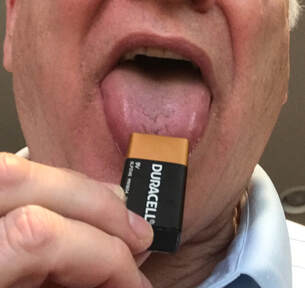|
A metallic taste is experienced by about 5% of patients who undergo routine MRI at 7T, but only rarely at 3T or below. Originally proposed to arise from the liberation of metals from dental fillings, the phenomenon occurs in patients without fillings. The true cause, instead, is generation of electric currents in the tongue due to magnetically induced electric fields. A similar taste can be produced by holding a 9-V battery to one's tongue.
LIke the generation of magnetophosphenes, head motion at low frequencies in a static field accentuates the phenomenon, with magnetic flux changes (dB/dt) on the order of 2 T/s required.
|
Advanced Discussion (show/hide)»
No supplementary material yet. Check back soon!
References
Cavin ID, Glover PM Bowtell RW, Gowland PA. Thresholds for perceiving metallic taste at high magnetic field. J Magn Reson Imaging 2007; 26:1357-1361. [DOI link]
Grant A, Metzger GJ, van de Moortele P-F, et al. 10.5 T MRI static field effects on human cognitive, vestibular, and physiological function. Magn Reson Imaging 2020; 73:163-176. [DOI LINK]
Rauschenberg J, Nagel AM, Ladd S, et al. Multicenter study of subjective acceptance during magnetic resonance imaging at 7 and 9.4 T. Invest Radiol 2014; 49:249-259. [DOI link]
Weintraub MI, Khouri A, Cole SP. Biologic effects of 3 Tesla (T) MR imaging comparing traditional 1.5T and 0.6 T in 1023 consecutive outpatients. J Neuroimaging 2007; 17:241-245. [DOI link]
Yilmaz S, Aiden MZ. Ex vivo mercury release from dental amalgam after 7.0-T and 1.5-T MRI. Radiology 2018; 288:799-803. [DOI link] (Controversial claim that mercury may be released from fillings at 7 T, disputed by Burkett et al from Mayo Clinic; but this is not the explanation for MR-induced metallic taste sensations in any case).
Cavin ID, Glover PM Bowtell RW, Gowland PA. Thresholds for perceiving metallic taste at high magnetic field. J Magn Reson Imaging 2007; 26:1357-1361. [DOI link]
Grant A, Metzger GJ, van de Moortele P-F, et al. 10.5 T MRI static field effects on human cognitive, vestibular, and physiological function. Magn Reson Imaging 2020; 73:163-176. [DOI LINK]
Rauschenberg J, Nagel AM, Ladd S, et al. Multicenter study of subjective acceptance during magnetic resonance imaging at 7 and 9.4 T. Invest Radiol 2014; 49:249-259. [DOI link]
Weintraub MI, Khouri A, Cole SP. Biologic effects of 3 Tesla (T) MR imaging comparing traditional 1.5T and 0.6 T in 1023 consecutive outpatients. J Neuroimaging 2007; 17:241-245. [DOI link]
Yilmaz S, Aiden MZ. Ex vivo mercury release from dental amalgam after 7.0-T and 1.5-T MRI. Radiology 2018; 288:799-803. [DOI link] (Controversial claim that mercury may be released from fillings at 7 T, disputed by Burkett et al from Mayo Clinic; but this is not the explanation for MR-induced metallic taste sensations in any case).
Related Questions
What causes the flickering lights observed by some MRI patients?
What causes the flickering lights observed by some MRI patients?

